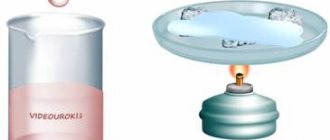Aggregate states of substances
All substances under normal conditions can exist in three states: solid, liquid and gaseous. Such states of substances are called aggregate states
.
For example, under normal conditions, water is in a liquid state of aggregation; at a temperature of 0 0C, water is in a solid state of aggregation (this is the well-known ice). The ice pattern on the glass, snow and a giant iceberg are all solid state of aggregation of water.
If water is heated to a temperature of 100 0C, it turns into a gaseous state, the so-called steam. This steam is a collection of tiny water droplets. Clouds are billions of tiny droplets of water.
Most gaseous substances
are colorless, so they cannot be seen. While in the vessel, they take its shape. The volume of gases depends on temperature and pressure, so gases are compressible. This property is widely used. For example, with the help of compressed air, doors on a bus are closed and opened, the flow of hot gases from a jet engine lifts airplanes into the air, and a parachute canopy filled with elastic air allows them to smoothly descend to the ground.
However, this “weightlessness” of gases is a relative concept. For example, two identical beakers stand on two counterbalanced scales. Visually we will not see gases here. Carbon dioxide can easily be “poured” from vessel to vessel. If you take a glass of carbon dioxide and “pour” it into one of the glasses, then the scales go down. Carbon dioxide fills the glass and displaces the air from it, so the scales go down. From this we can conclude that carbon dioxide is heavier than air.
.
Undoubtedly, pour liquids
more familiar and clear.
If a liquid is poured into a vessel, it will take the shape of the vessel into which it was poured. This reflects such a property of a liquid as fluidity
.
Some liquids spread quite quickly over a flat surface, for example, water, alcohol, gasoline, acetone. Other liquids – very slowly. So, a drop of honey on the glass will spread very slowly; in order to do this, you need to place the glass vertically. Liquids, unlike gases, are practically not compressible
. If you slap the surface of the water, the effect will be the same as if you slap the table top.
If a liquid is cooled, it turns into a solid state of aggregation. Solids
retain their volume and shape, they practically
do not shrink
. So, ice cubes will always have their shape and volume, no matter where we move them, until they melt.
Diffusion, Brownian motion, the transition of substances from one state of aggregation to another are classified as physical phenomena
, since there is no transformation of one substance into another.
Thus, physical phenomena
- these are phenomena in which the aggregate states of substances, the shape and size of bodies built from this substance change, but their chemical composition is preserved.
In gaseous substances, the distance between molecules is tens of times greater than the size of the molecules themselves, so they are weakly bound to each other and gases are easily compressed. In solids, the particles of which they are composed are located close to each other and in a certain order, like soldiers in formation. Crystals have such an ordered structure of particles. The attractive forces of particles in crystals are strong; tearing off these particles is very difficult.
Liquids are something intermediate between gases and solids.
Liquids have volume, like solids, the distance between molecules is small, but the forces of attraction between particles are not as strong as in crystals.
There are also substances that are so viscous that they retain their shape for a long time, like solids, but the arrangement of particles in them is disordered, like in liquids. Such substances are called amorphous
. Amorphous substances include amber, wax, glass, resins, and many plastics.
But how can you distinguish a crystalline substance from an amorphous one? If, for example, you heat glass, it will soften, then become fluid until it turns into a typical liquid. That is, there is no sharp boundary between amorphous substances and liquids.
Every solid substance has a certain melting point at which it changes from solid to liquid.
Physics 7th grade. Structure of matter
Physics 7th grade Notes Structure of matter Initial information about the structure of matter. Diffusion. Aggregate states of matter.
Problems on the topic Structure of matter
All substances consist of tiny particles: atoms, molecules, ions.
A molecule of a substance is the smallest particle of a given substance.
Particles of matter are in continuous chaotic motion.
Brownian motion of molecules
Among the main experimental evidence that molecules move is a phenomenon that was first observed in 1827 by the English botanist Robert Brown.
History of the discovery of Brownian motion
The movement of very small solid particles in a liquid is called Brownian motion . The reason for Brownian motion lies in the continuous, never-ending movement of molecules of a liquid (gas) in which grains of a solid are located.
Diffusion is a phenomenon in which mutual penetration of molecules of one substance between molecules of another occurs.
Diffusion also occurs in solids, but only very slowly.
Diffusion in metals
The diffusion process accelerates with increasing temperature, because As the temperature increases, the speed of movement of molecules increases.
Diffusion example:
spreading the smell of perfume or coffee
Diffusion in liquid
There is interaction between the molecules of a substance - mutual attraction and repulsion. The attraction between molecules in different substances is not the same.
At distances comparable to the size of the molecules (atoms) themselves, attraction becomes more noticeable, and with further approach, repulsion becomes more noticeable.
In nature, a substance can be in one of three states of aggregation : solid, liquid, gaseous.
The arrangement of molecules in different states of matter
Properties of aggregate states of substances
Solid:
- has its own shape and volume
- difficult to change shape and volume
- molecules (atoms) are arranged in a certain order (crystals)
- strong attraction between molecules (atoms)
- molecules (atoms) vibrate around a certain point.
Liquid
- takes the shape of the container in which it is located
- easily changes its shape
- maintains volume (difficult to change)
- molecules are located close to each other
- molecules do not move apart over long distances
- the attraction between molecules is not very strong
- liquids are fluid.
Gas
- do not have their own shape and constant volume
- completely fill the volume provided to them
- easily change shape and volume
- molecules are located far apart from each other
- molecules have almost no attraction to each other.
The same substance can be in different states of aggregation.
Example of aggregate states:
water – ice (solid), water (liquid), steam (gaseous).
Introduction
Tasks
Mechanical movement
The abstract was compiled on the basis of theoretical material from the textbook “Physics 7th grade” by A.V. Peryshkin
Download abstract:
teoriya_7_stroenieveshhestva
Related posts:
Physics 7th grade. Path and time
Physics 7th grade. Speed
Physics 7th grade. Weight
Physics 7th grade. Density
Liquid state
By increasing pressure and/or decreasing temperature, gases can be converted to a liquid state. At the dawn of the 19th century, the English physicist and chemist Michael Faraday managed to transform chlorine and carbon dioxide into a liquid state by compressing them at very low temperatures. However, some of the gases did not yield to scientists at that time, and, as it turned out, the problem was not insufficient pressure, but in the inability to reduce the temperature to the required minimum.
A liquid, unlike a gas, occupies a certain volume, but it also takes the form of a filled container below surface level. Visually, the liquid can be represented as round beads or cereal in a jar. The molecules of a liquid are in close interaction with each other, but move freely relative to each other.
If a drop of water remains on the surface, it will disappear after some time. But we remember that thanks to the law of conservation of mass-energy, nothing disappears or disappears without a trace. The liquid will evaporate, i.e. will change its state of aggregation to gaseous.
Evaporation
—
is a process of transformation of the state of aggregation of a substance, in which molecules, whose kinetic energy exceeds the potential energy of intermolecular interaction, rise from the surface of a liquid or solid
.
Evaporation from the surface of solids is called sublimation
or
sublimation
. The easiest way to observe sublimation is to use naphthalene to combat moths. If you smell a liquid or solid, evaporation is occurring. After all, the nose is what catches the fragrant molecules of the substance.
Liquids surround humans everywhere. The properties of liquids are also familiar to everyone - viscosity and fluidity. When it comes to talking about the shape of a liquid, many people say that the liquid does not have a specific shape. But this only happens on Earth. Due to the force of gravity, a drop of water is deformed.
However, many have seen how astronauts in zero gravity conditions catch water balls of different sizes. In the absence of gravity, the liquid takes the shape of a sphere. And the force of surface tension provides the liquid with a spherical shape. Soap bubbles are a great way to become familiar with the force of surface tension on Earth.
Another property of a liquid is viscosity. Viscosity depends on pressure, chemical composition and temperature. Most liquids obey Newton's law of viscosity, discovered in the 19th century. However, there are a number of highly viscous liquids that, under certain conditions, begin to behave like solids and do not obey Newton's law of viscosity. Such solutions are called non-Newtonian liquids. The simplest example of a non-Newtonian fluid is a suspension of starch in water. If a non-Newtonian fluid is subjected to mechanical forces, the fluid will begin to take on the properties of solids and behave like a solid.
What else should I read?
Potential energy. How is it related to work?
First law of thermodynamics. How to tell something complicated simply?
What is the Doppler Effect? We explain with examples
Archimedes' Law, or How to Recognize a Lie?






